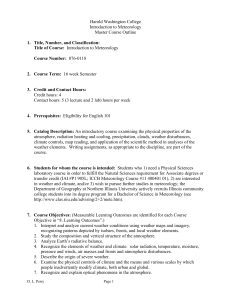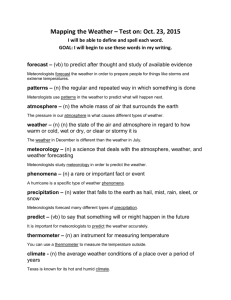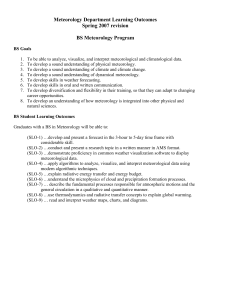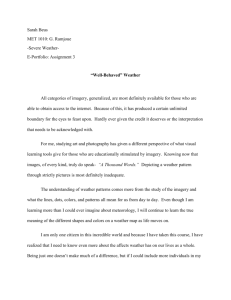The State of Climate and Weather in South Africa
advertisement
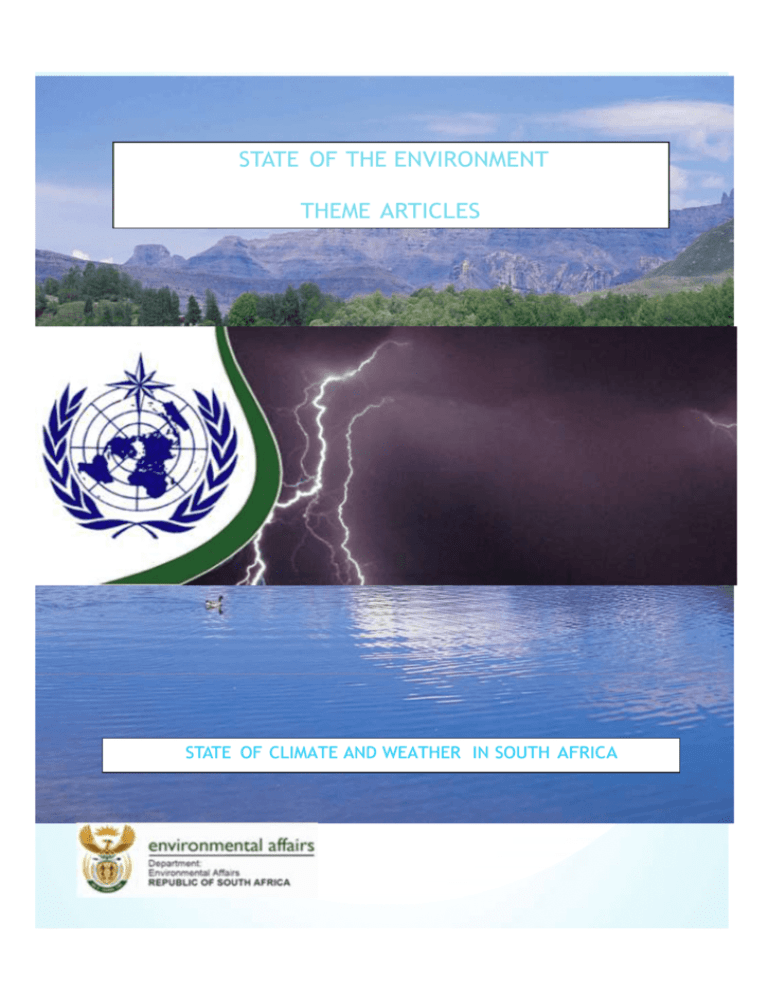
STATE OF THE ENVIRONMENT THEME ARTICLES STATE OF CLIMATE AND WEATHER IN SOUTH AFRICA The State of Climate and Weather in South Africa restricted eventually to the study of the atmosphere. Various weather phenomena INTRODUCTION Meteorology is the study of the Earth's atmosphere and the variations in temperature and moisture patterns that produce different weather conditions. Some of the major subjects of study are such phenomena as precipitation (rain and snow), thunderstorms, tornadoes, and hurricanes and typhoons. are still referred to as "meteors," such as hydrometeors (liquid or frozen water rain, snow and snowflakes, clouds, fog), lithometeors (dry particles sand, dust, or smoke), photometeors (optical phenomena halos, mirages, rainbows, coronas), and electrometeors (electrical phenomena lightning, Saint Elmo's fire). The importance of meteorological events is felt in various ways. For example, a drought results in water shortages, crop damage, low river flow rates, and increased wildfire potential. In addition, these effects may lead to restricted river travel, saltwater infiltration in aquifers and coastal bays, stress on various plant and animal species, population shifts, economic hardship, and even political unrest. The critical impact of weather on human activity has led to the development of the uncertain science of weather forecasting. Source: SA Tourism Modern meteorology focuses primarily on the typical weather patterns observed, including thunderstorms, extratropical The word meteorology derives from the cyclones, fronts, hurricanes, typhoons, and Greek word meteoron, which refers to any various tropical water waves. Meteorology phenomenon Aristotle's is usually considered to describe and study Meteorologica (340 B.C.) concerned all the physical basis for individual events. In phenomena above the ground. Astronomy, contrast, climatology describes and studies including the the in the study sky. of meteors, or origin of atmospheric patterns "shooting stars," later became a separate observed over time. Several important discipline. The science of meteorology was phenomena, such as monsoons and the El The State of Climate and Weather in South Africa NiñoSouthern Oscillation, are considered in both meteorology and climatology because they exhibit large changes on seasonal time scales. Source: http://www.scholastic.com/teachers/article/ meteorology trapping sediment and holding the soil is reduced. This reduces the benefits that society receives from the wetland in purifying water and controlling erosion. Impacts on wetlands result from both onsite activities at the wetland site (e.g. drainage, disturbance through cultivation, IMPACTS OF HUMAN ACTIVITIES infiling and flooding by dams) and from ON CLIMATE AND WEATHER off-site activities in wetland’s the surrounding catchment (e.g. afforestation, Human activities contribute to climate mining and crop production) change by causing changes in Earth’s atmosphere in the amounts of greenhouse Observations show that there have been gases, aerosols (small particles), and changes in weather. As climate changes, cloudiness. The largest known contribution the probabilities of certain types of comes from the burning of fossil fuels, weather events are affected. Changes have which releases carbon dioxide gas to the been observed in the amount, intensity, atmosphere. Greenhouse gases and aero- frequency, and type of precipitation. sols affect climate by altering incoming Widespread solar radiation and out-going infrared precipitation have occurred, even in places (thermal) radiation that are part of Earth’s where total rain amounts have decreased. energy balance. Changing the atmospheric With medium confidence. IPCC (2012) abundance or properties of these gases and concluded that human influences had particles can lead to a warming or cooling contributed to an increase in heavy of the climate system. Since the start of the precipitation events at the global scale. industrial era (about 1750), the overall effect of human activities on climate has been a warming influence. The human impact on climate during this era greatly exceeds that due to known changes in natural processes, such as solar changes and volcanic eruptions. Projections increases of future in heavy changes in precipitation show overall increases in the global average, but with substantial shifts in where and how precipitation falls. Projections suggest a reduction in rainfall in the subtropics, and an increase in precipitation in subpolar latitudes and The State of Climate and Weather in South Africa some equatorial regions. In other words, previous year, and some years show regions which are dry at present will in greater changes than others. These year-to- general become even drier, while regions year fluctuations in temperature are due to that are currently wet will in general natural processes, such as the effects of El become even wetter. This projection does Niños, La Niñas, and the eruption of large not apply to every locale, and in some volcanoes. Notably, the 20 warmest years cases can be modified by local conditions. have all occurred since 1981, and the 10 warmest have all occurred in the past 12 years. Source: http://za.ask.com/wiki/Physical_impacts_o f_climate_change?qsrc=3044 THE STATE OF CLIMATE AND WEATHER IN SOUTH AFRICA South Africa’s rainfall is already highly variable in spatial distribution and unpredictable, both within and between Source: years. Much of the country is arid or semi- http://za.ask.com/wiki/Effects_of_global_ arid and the whole country is subject to warming?lang=en#Effects_on_weather droughts and floods. Bulk water supplies are largely provided via a system of large Global average temperature is one of the most-cited indicators of global climate change, and shows an increase of approximately 1.4°F since the early 20th Century. The global surface temperature is based on air temperature data over land and sea-surface temperatures observed from ships, buoys and satellites. There is a clear long-term global warming trend, while each individual year does not always show a temperature increase relative to the storage dams and interbasin water transfer schemes and such infrastructure takes years to develop. Thus a reduction in the amount or reliability of rainfall, or an increase in evaporation would exacerbate the already serious lack of surface and ground water resources. Water availability in the arid and semi-arid regions, which cover nearly half of South Africa, is particularly precipitation. sensitive to changes in The State of Climate and Weather in South Africa The temperature in south Africa is making a fair contribution to the projected to increase by between a and 3 global degrees and the country’s rainfall is stabilisation projected to decrease by 5-10%. That concentrations in the atmosphere at a means more extremely hot days of greater level consequence for south Africa as a semi- anthropogenic interference with the arid country is the prediction that a broad climate system; and reduction of rainfall in the range 5% to 10% ce be expected in the summer rainfall rainfall greenhouse gas prevents dangerous effectively adapt to and manage South Africa’s social, economic and followed by intense storms. A marginal winter the interventions that build and sustain floods with prolonged dry spells being early of achieve climate change impacts through increasing incidence of both droughts and in that to unavoidable and potential damaging region. This will be accompanied by an increase effort environmental is resilience and emergency response capacity. predicted for the winter rainfall region of the country. 2. United Nations Framework Convention on climate change, the ultimate objective Source: A National Climate Change Response Strategy for South Africa, September 2004 of this Convention and any related legal instruments that the Conference of the SOUTH AFRICA’S RESPONSE TO CLIMATE CHANGE Parties may adopt is to achieve, in accordance with the relevant provisions of the Convention, stabilization of The key responses and interventions greenhouse gas concentrations in the towards remedying impacts of climate are: atmosphere at a level that would prevent 1. National Climate change response strategy, South Africa, taking into account equity and the common but differentiated responsibilities and respective capabilities of all nations as well as the intergenerational commitment of the Environmental Right contained in Section 24 the country’s Constitution, has the climate change response objective of – dangerous anthropogenic interference with the climate system. Such a level should be achieved within a time frame sufficient to allow ecosystems to adapt naturally to climate change, to ensure that food production is not threatened and to enable economic development to proceed in a sustainable manner. The State of Climate and Weather in South Africa 3. National Environmental Management: meteorological Air Quality Act no. World Meteorological Day around a 4. National Environmental Management Act, No 107 of 1998 is the legislation for environmental protection and sustainable development. Management in the Republic of South celebrate chosen theme. This day commemorates the entry into force, on that date in 1950, of the WMO Convention Organization. WMO 6. National Framework for Air Quality community was creating Subsequently, designated a in the 1951, specialized agency of the United Nations System. Important facts: Africa, the establishment of the 2007 National Framework for Air Quality Management~ is a milestone in government’s attempts to introduce a new efficient and effective air quality management regime in South Africa. For the first time, all interested South Africans. have contributed to the establishment of the first national plan to clear our skies of pollution and ensure ambient air that is not harmful to health and well-being. WORLD METEOROLOGICAL DAY Climatological data collected and processed over many years by the South African Weather Service play an extremely important role during the planning phase in the construction industry (buildings, dams, bridges, etc.), in agriculture, forestry and aviation, determining flood levels, etc. Timely forecasts of hazardous weather (extremes of cold and heat, heavy rain, etc.) can save the country millions of rand every year. 2013 Source: http://www.wmo.int/worldmetday/index_e n.html REFERENCES The 2013 World Meteorological Day will be celebrated under the theme "Watching the weather to protect life and property". Each year, on 23 March, the World Meteorological Members Organization, and the its 191 worldwide 1. A National Climate Change Response Strategy for South Africa, September 2004 2. Effects on weather http://za.ask.com/wiki/Effects_of_global_ warming?lang=en#Effects_on_weather The State of Climate and Weather in South Africa 3. Meteorology http://www.scholastic.com/teachers/art icle/meteorology 4. Physical impacts of climate change http://za.ask.com/wiki/Physical_impact s_of_climate_change?qsrc=3044 5. http://www.wmo.int/worldmetday/inde x_en.html
